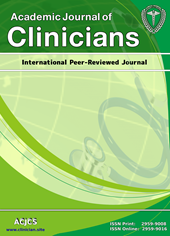Saliva Diagnostics of the Level of Endogenous and Exogenous Blood Components
Keywords:
Salivary gland, Saliva, Blood component, Endogenous, ExogenousAbstract
In recent years, due to the work on the physiology of the salivary glands, the established ability to transform the composition of saliva depending on the composition of the blood. Interest in saliva diagnostics of human homeostasis has increased and it finds application in immunology , enzymology , endocrinology , psychophysiology and gastroenterology due to the availability of the object of study and the large information potential of the amount and composition of saliva, which was noted by I. P. Pavlov in 1923 in arguing for the method of accounting for salivation in the physiology of conditioned reflexes. Of theoretical and applied interest is the study of the possibilities of saliva diagnostics in characterizing the composition of blood by exogenous and endogenous substances, its disorders and correction. In the theoretical and practical development of priority aspects of human ecology, preventive clinical toxicology, a special place is occupied by the problem of exogenous toxic effects of low intensity. The accumulation of residual amounts of organochlorine pesticides in human bioenvironments has a negative effect on the health of large groups of the population. Despite the long history of study, this problem has not been sufficiently solved in a methodological sense and in terms of medical and ecological rehabilitation of the population of ecologically unfavorable regions. Therefore, our main task is to study the influence of hyperfermentemia on the enzyme spectrum of saliva and oral fluid in comparison with the spectrum of blood hydrolases, as a realization of the secretory activity of the salivary glands and determination of the possibilities of saliva diagnostic control of the results of drug correction of hyperfermentemia. Additionall, we planed for examine the present method for the determination of isoamylases in oral fluid, saliva and blood serum using the inhibitor of human salivary amylase.
Downloads
References
Wang Y, et al. Saliva-based hormone diagnostics: advances, applications, and future perspectives. Expert Rev Mol Diagn. 2025;25(5):123-134.
Chen X, et al. Saliva as a diagnostic tool for systemic diseases—A narrative review. Crit Rev Clin Lab Sci. 2025;62(3):240-258.
Ranjan R, et al. Evaluation of salivary diagnostics: applications, benefits, challenges, and future prospects. Diagnostics. 2024;14(2):150.
Zhang L, et al. Promising applications of saliva biomarker testing in clinical diagnostics. Theranostics. 2023;13(1):56-66.
Lee CH, et al. Salivary diagnostics: opportunities and challenges. Clin Chem Lab Med. 2023;61(4):410-420.
Humpel C, et al. Challenges to the reliability of saliva-based diagnostics for brain disorders. J Neurochem. 2023;164(6):745-756.
Ebersole JL, et al. Saliva as a diagnostic tool for blood group determination. J Clin Lab Anal. 2022;36(8):e24607.
Galasso G, et al. Blood contamination in salivary diagnostics: current methods and limitations. Clin Chem Lab Med. 2021;59(5):803-810.
Kaczmarek U, et al. Salivary biomarkers for cancer diagnostics: a review. Biomarkers Med. 2021;15(2):123-139.
Pacheco D, et al. Salivary diagnostics for endocrine disorders: a review. Endocrine. 2020;68(3):639-652.
Monteiro M, et al. Saliva as a diagnostic tool in the detection of systemic diseases. J Oral Pathol Med. 2020;49(7):645-651.
Scully C, et al. Salivary diagnostics in the detection of blood components. Oral Dis. 2019;25(7):1740-1750.





